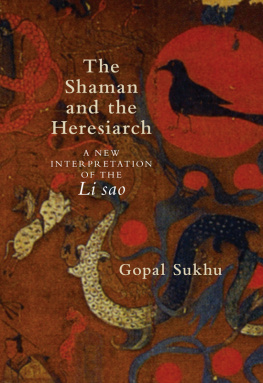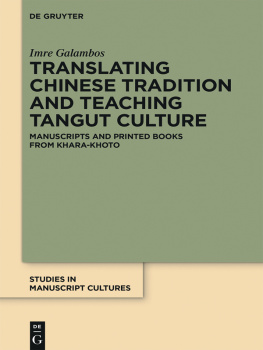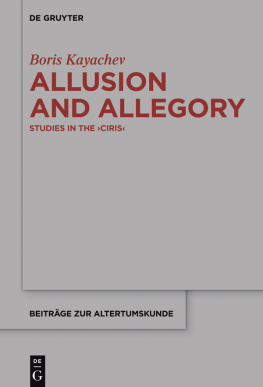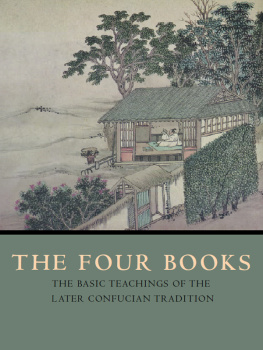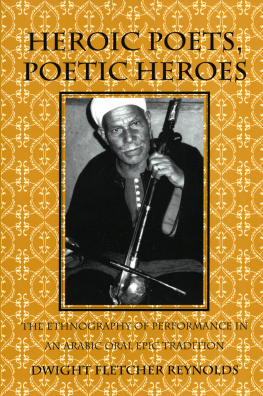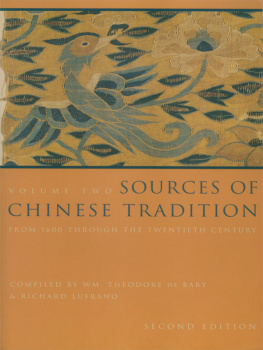SUNY SERIES IN CHINESE PHILOSOPHY AND CULTURE
Roger T. Ames, editor
The Shaman and the Heresiarch
A New Interpretation of the Li sao
GOPAL SUKHU

Cover image of Western Han Chinese silk courtesy of Wikimedia Commons
Published by
STATE UNIVERSITY OF NEW YORK PRESS
Albany
2012 State University of New York
All rights reserved
Printed in the United States of America
No part of this book may be used or reproduced in any manner whatsoever without written permission. No part of this book may be stored in a retrieval system or transmitted in any form or by any means including electronic, electrostatic, magnetic tape, mechanical, photocopying, recording, or otherwise without the prior permission in writing of the publisher.
For information, contact
State University of New York Press
www.sunypress.edu
Production, Diane Ganeles
Marketing, Michael Campochiaro
Library of Congress Cataloging-in-Publication Data
Sukhu, Gopal.
The shaman and the heresiarch : a new interpretation of the Li sao / Gopal Sukhu.
p. cm. (Suny series in Chinese philosophy and culture)
Includes bibliographical references.
ISBN 978-1-4384-4283-9 (hardcover : alk. paper)
1. Qu, Yuan, ca. 343-ca. 277 B.C. Li sao. 2. Shamanism in literature. I. Qu, Yuan, ca. 343-ca. 277 B.C. Li sao. English. II. Qu, Yuan, ca. 343-ca. 277 B.C. Jiu ge. III. Title. IV. Title: New interpretation of the Li sao.
PL2661.L53S85 2012
895.1'11dc23
2011034433
10 9 8 7 6 5 4 3 2 1
Dedicated to the memory of my teacher, Professor Wu Pei-yi
Acknowledgments
Now that I have been a teacher of Asian literature for well over a decade, I look back in gratitude, and sometimes wonder, to those who taught me. My first teacher, one of the very best, was Mrs. Yuan Ming-ch'iu, who had the good fortune to teach me when I was still a decent student. At Yale University, for various personal reasons, I became quite the opposite. Those unfortunate enough to have me as a student then were Hugh Stimson, who taught me linguistic rigor; Hans Frankel, who taught me Tang poetry; Jonathan Spence, who would have taught me many things if I had simply shown up; and Stanley Insler, who in trying to teach me Sanskrit taught me how to critically approach traditional commentaries.
There is such a thing as profitably wasting timebut only while one is young. I tried to make amends by going to Taiwan where the teachers at the Guoyu Ribao, and fine tutors like Luo Chi-yun, one of the best students of Chen Guying, helped me relaunch my boat. Columbia University, and especially the great C. T. Hsia, who taught me the vernacular of the Yuan, Ming, and Qing dynasties, offered me a second harbor. I am especially indebted to the late Charles Lo, who taught me how to get through Qing officialese; Hans Bielenstein, who taught me the rigorous reading methods of his teacher, Bern hard Karlgren; Robert Ramsey, who taught me historical phonology; Paul Rouzer, who taught me Li Bai and how to finish a doctoral dissertation and enter the professorial world; and my mentor, Professor Wu Pei-yi, who taught me everything.
My work on the Li sao could not have been undertaken without the help of the professors on the cutting edge of Chu Studies in ChinaShi Quan, Wang Guanghao, and Xu Shaohua, and many others in the History and Archaeology Department at Wuhan Universityproviding me a transformative cultural perspective on ancient Chinese literature. My thanks to them and to Tang Yiming, who wrote a letter of introduction to Professor Hu Guorui, with whom I had discussions on Chinese poetry that were as enlightening as they were entertaining. I am grateful also to what was then known as the Committee on Scholarly Communication with the People's Republic of China for the generous grant that allowed me the invaluable opportunity of going to China to learn from such scholars.
My heartfelt thanks also to those who kept me from sinking while I was writing the dissertation on which this book is based: Gari Ledyard, who, among other important things, lent me his office; Robert Hymes, who read my drafts and warned me of the unforeseen; Paul Anderer, who offered practical advice and one of the most enjoyable courses I have ever taken; Gina Bookhout, who mercifully saved me at many junctures; Jim Cuna, who saved me at the last minute; and Burton Watson, who having read the first chapter of the dissertation, advised me on what it means to be a translator and how to write a book.
I must also offer thanks to the three members of my doctoral defense committee who have since, unfortunately, passed away: Irene Bloom, the great Neo-Confucian scholar; Barbara Miller, the renowned Sanskritist; and Father Paul Serruys, a true sinologist of the old European tradition, who went through my Li sao glosses and translation with as fine-toothed a comb as I have ever seen, and whose approval, though characteristically sparing, gave me the confidence to go on.
I have benefited greatly from the suggestions and opinions of friends and colleagues who read earlier drafts of this book or heard my papers concerning relevant aspects of it. These are too numerous to mention in detail, but special thanks to Alexander Brown, Zia Jaffrey, Galal Walker, Lisa Raphals, Lothar von Falkenhausen, Mark Edwards, Henry Schwab, Stephen Field, Alain Thote, Elizabeth Childs-Johnson, Haun Saussy, Sonya Alland, Barry Blakely, Ellen Neskar, Ari Borel, Kidder Smith, Michael Puett, Paul Goldin, Laurel Kendall, Sarah Allan, Michael Schimmelpfennig, Constance Cook, and John Major. The last two were the first to give me a venue, and a push, to publish some of my ideas about Chu and Qu Yuan in print.
I am particularly grateful to Mick Stern, who read my translations of the Li sao and the Nine Songs with a poet's eye and suggested changes accordingly; and to Charlotte Boynton for her careful and skillful editing, citation checking, and proofreadingin Chinese, Japanese, and Englishin the preproduction stage of the manuscript. I, however, am responsible for the errors and infelicities that have no doubt crept in anyway.
Exposure to strong light helps things grow. It is hard to imagine developing ideas without the exposure to interested, and interesting, minds that small, specialist seminars provide. I am deeply indebted to Bruce and Takeo Brooks and their Warring States Working Group, which provided an opportunity to meet some of the greatest figures in the field of sinology in a nonhierachical atmosphere. It was, for me, one of the best places to test and develop some of my more radical ideas about the Li sao. The same may be said for the Early China Roundtable, a sort of spin-off group presided over by the indefatigable Moss Roberts, who has never been stinting in his support. My thanks also to the members of Professor Theodore de Bary's Neo-Confucian seminar, where I learned so much about how the tradition of Han classicism was changed by Song learning. My gratitude also to Li Feng, David Branner, and the other members of the Early China Seminar, also at Columbia, for one of the most stimulating sinological venues in the world.
I must also express appreciation to the Warner Fund at the University Seminars at Columbia University for their help in publication. The ideas presented here have also benefited from discussions in the University Seminar on Traditional China. The kind comments of Professors Murray Rubinstein and Konrad Schirokauer were especially helpful.
On the very long road from dissertation to book, I often had to depend on my friends for encouragement, sometimes of a practical nature. My deep gratitude in this regard goes to Lynn Horowitz, who handed me twine and long steel needles when it was time to mend my sails; to Matt Maltzman, who always found me a place to write and think when I was in Cambridge, and gave me the best encouragement of allthe faith of a skeptic; to Carol Weinhaus, who lent her apartment and served the greatest desserts I have ever eaten; to Don Cohn, who always offered shelter, food, music, books, ideas, and innumerable other good things at the gates Asia; to Eva Hung, who arranged a quiet place to carry on research at the Chinese University of Hong Kong; to Marie-Th erese Brincard and Cary Plotkin, for a regular supply of home-made gourmet dinners and late-night conversations; to Homer Williams and Laurel Kendall, who opened their home, found me work, and lent me computers; to Antonio Sanfilippo and Charlotte Boynton, who took me in when I had nowhere else to go; to David Polonoff, for stimulating talk and an introduction to the world of the night proofreader; to Kenichi Haga and Yuko Yano, who helped me maintain my health; to Beatice Coron and Warren Stein, for dinner parties, art, and an introduction to the world of the interpreter-guide; to Serinity Young, for showing me where the money is; to maestro Stephen Sulich for encouraging words; to Enrique Martinez, for a balcony on summer nights, a bicycle, the stories, and flamenco.
Next page
